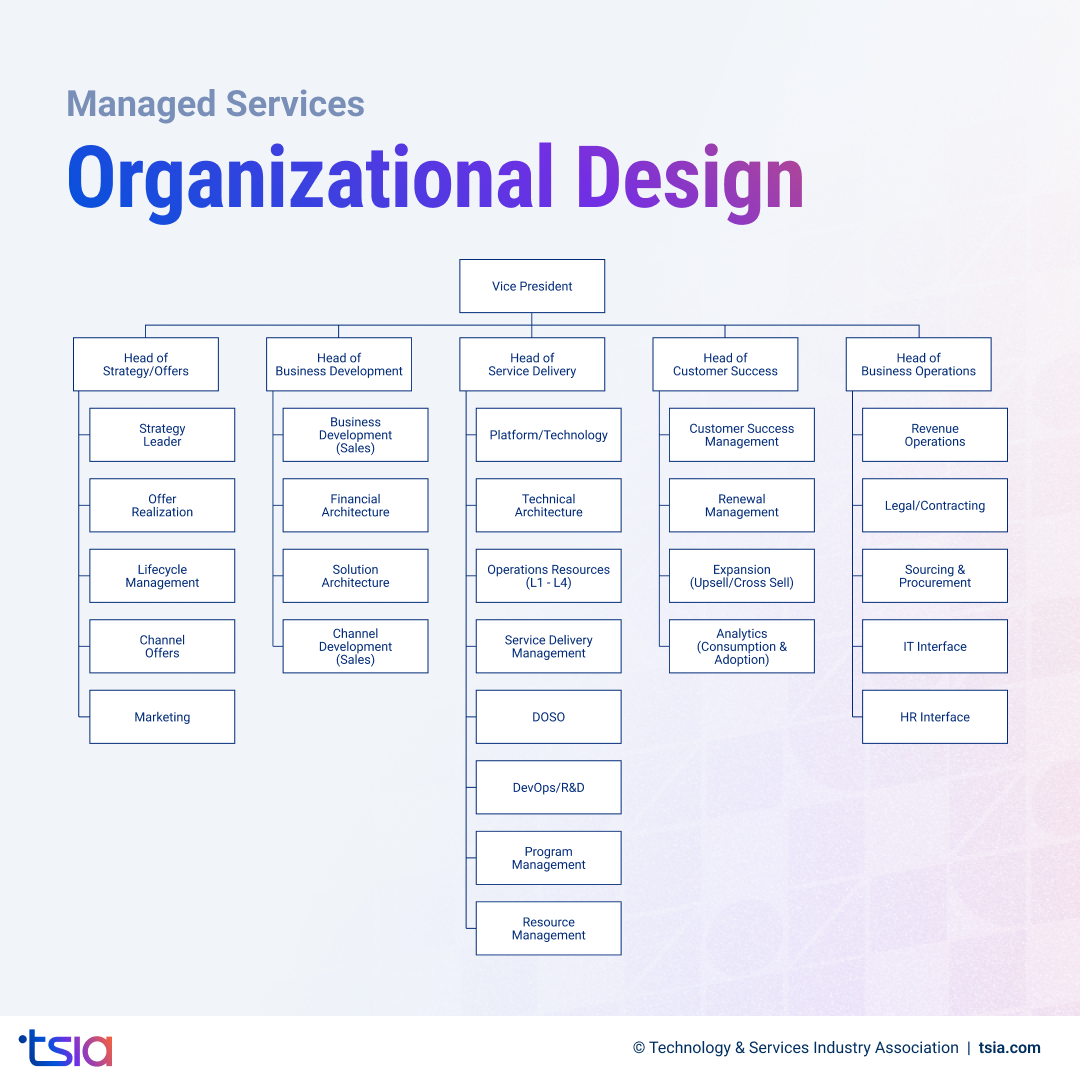If you're building or expanding a managed services business, your organizational structure is just as critical as your technology or service offerings. Managed services isn't a product line or a support add-on—it’s its own business with unique operational, financial, and customer requirements. That means you need to structure your team accordingly, with clearly defined roles and dedicated leadership.
Without the proper structure, managed services can quickly become a low-margin side hustle. However, with a solid foundation and focused talent across the right functional areas, you can drive recurring revenue, meet SLAs, and create a sustainable growth engine for your company.
This blog outlines the key roles, functions, and maturity stages of a high-performing managed services organization—and how you can scale yours with confidence.
Key Takeaways
- A managed services business requires a well-defined structure, effective leadership, and specialized roles, not just a repurposed product or support team.
- Core functions include strategy and offers, business development, service delivery, customer success, and business operations.
- As your business grows, your organizational structure should evolve from a lean and flexible one to a specialized and scalable one.
What Makes Managed Services Different?
Unlike product-based or one-time service delivery models, managed services are a long-term commitment. They require you to deliver consistent outcomes over time, maintain service-level agreements, and build deep relationships with customers.
That’s why the organizational design must reflect this complexity. You need a team that not only understands the technical side of service delivery but also the financial, operational, and customer success levers that drive long-term value. Treat managed services as its business line—with its own leadership, goals, and support structure.

The 5 Core Functional Areas of a Managed Services Business
To run a profitable and scalable managed services business, you need dedicated leaders and teams across these five areas.
1. Strategy and Offers
This team defines what services you offer, ensures they align with customer needs, and positions your business for long-term success. Key roles include:
- Strategy lead: Aligns managed services with company goals.
- Offer realization manager: Builds the service offering, from business case to launch.
- Offer lifecycle manager: Manages updates, pricing, and sunsetting of offers.
- Channel offer manager: Adapts offers for partner channels.
- Marketing manager: Drives demand and communicates value.
2. Business Development
Selling managed services is different from selling products. This function focuses on value realization, not just features. Key roles include:
- Business development manager: Owns the managed services sales cycle and coordinates handoffs to delivery.
- Financial architecture expert: Handles deal profitability and pricing.
- Solution architecture expert: Ensures technical solutions align with delivery capabilities.
- Channel development manager: Builds and manages partner sales opportunities.
3. Service Delivery
This team ensures what you sell can be delivered reliably and efficiently, with a focus on customer outcomes. Key roles and capabilities include:
- Head of delivery: Oversees operations and ensures delivery aligns with promises.
- Platform and technical architecture: Designs the tech stack for scalability and compliance.
- Operations resources: Tiered support (Level 1–4) for incident management and technical expertise.
- Service delivery management: Customer-facing delivery roles that manage SLAs and technical onboarding.
- DevOps and R&D: Support service innovation and automation.
- Program and resource management: Aligns people, tools, and projects for efficient execution.
4. Customer Success
Customer success in managed services primarily hinges on building and maintaining strong relationships. This team drives adoption, renewals, and expansion with a hands-on approach. Key roles include:
- Customer success manager: Primary contact post-sale, focused on business outcomes.
- Renewal manager: Proactively manages contract renewals.
- Expansion and cross-sell manager: Identifies and closes growth opportunities to drive business expansion and revenue growth.
- Adoption analyst: Monitors usage patterns to identify risks and opportunities.
Related: Driving Business Value Through Customer Success in Managed Services
5. Business Operations
The backbone of your organization, business operations ensures everything runs smoothly behind the scenes—from revenue tracking to HR support. Key responsibilities include:
- Revenue operations: Builds processes and analytics for recurring revenue.
- Legal and contracting: Manages compliance, negotiations, and risk.
- Sourcing and procurement: Finds and manages key vendors.
- IT interface: Aligns delivery tech with the company's IT infrastructure.
- HR interface: Supports hiring, development, and retention of managed services talent.
Stages of MSP Organizational Maturity
Your org structure should evolve as your business grows. Here’s a simplified three-stage model to guide your progress:.
Stage 1: Early-Stage MSP
- Lean team, often with shared roles.
- One leader might handle both delivery and customer success.
- Focused on landing initial clients and establishing offers.
Stage 2: Scaling MSP
- Dedicated leaders for core functions (e.g., delivery, business development).
- Offers become more formalized.
- Processes start to support repeatable growth.
Stage 3: Mature MSP
- Specialized roles and layered management.
- Automation, analytics, and cross-functional alignment.
- Complete focus on scaling profitably and improving margins.
Related: TSIA Managed Services Benchmarking

How To Structure or Evolve Your Team
Whether you're starting fresh or revisiting your current structure, here’s a quick framework to help guide your efforts:
- Assess your current state: Map out who owns what across strategy, sales, delivery, customer success, and ops.
- Identify the gaps: Are you missing critical roles? Are specific functions overloaded or overlapping?
- Prioritize by stage: Focus on adding roles where the return will be highest based on your growth stage.
- Revisit quarterly: As your managed services business grows, its structure will also need to evolve.
A successful managed services organization doesn’t happen by accident. It takes intentional design, clear ownership, and cross-functional collaboration. By treating managed services as its own business line—and investing in the proper structure—you’ll position your company to drive recurring revenue, deliver value at scale, and build long-term customer loyalty.
Trying to manage it all with a borrowed product team or an ad hoc delivery model simply won’t suffice. Get the structure right, and the results will follow.
Related: The Future of Managed Services: AI's Impact on Organization Structures

FAQ
What are the most critical roles to start with in a managed services organization?
Start with leaders who can own delivery, business development, and strategy. These three functions form the foundation of a scalable organization.
How does TSIA Intelligence help with structuring a managed services business?
TSIA Intelligence provides frameworks, best practices, and benchmarking to help you design and evolve your MSP organization with confidence.
What tools can help benchmark and evaluate my current structure?
TSIA’s Performance Optimizer enables you to evaluate your managed services capabilities and pinpoint gaps in comparison to industry standards.
Smart Tip: Embrace Data-Driven Decision Making
Making smart, informed decisions is more crucial than ever. Leveraging TSIA’s in-depth insights and data-driven frameworks can help you navigate industry shifts confidently. Remember, in a world driven by artificial intelligence and digital transformation, the key to sustained success lies in making strategic decisions informed by reliable data, ensuring your role as a leader in your industry.













